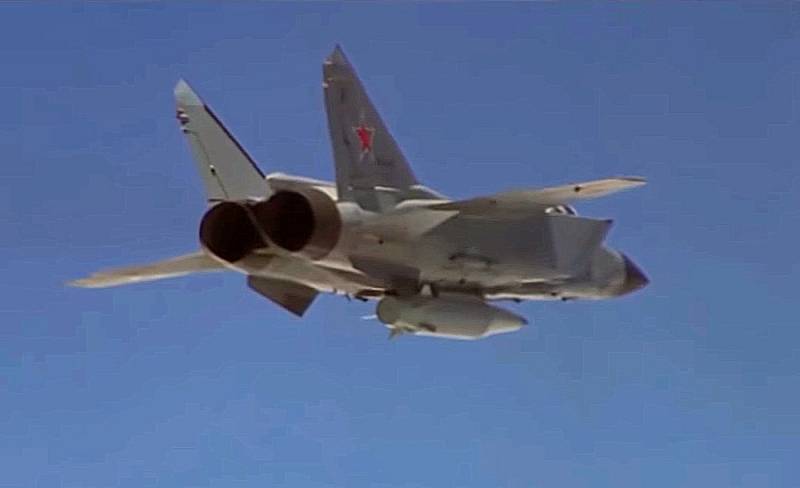Why Russia needed hypersonic weapons in the Eastern Mediterranean
After spending some time in the Kaliningrad region, the MiG-31K supersonic fighters, equipped with Kinzhal hypersonic missiles, returned to the airfield in the Western Military District. Judging by the publications in the American press, the Russian hint was seen in the West, appreciated and taken into account. Now the Ministry of Defense of the Russian Federation has transferred carriers of "Daggers" to Syria, and even together with Tu-22M3 supersonic bombers armed with powerful Kh-32 anti-ship missiles. Why were "Putin's rockets" needed in the Eastern Mediterranean?
The Russian Defense Ministry commented on the transfer of aircraft to friendly Syria as follows:
Long-range aircraft Tu-22M3 and MiG-31K with the Kinzhal aviation complex were relocated to the Khmeimim airfield (SAR) to participate in a naval exercise of the inter-fleet grouping of the Navy in the eastern Mediterranean Sea. The crews of the Russian Aerospace Forces completed the flight from the points of deployment, covering more than 1,5 thousand km. During the exercise, long-range aviation pilots will have to perform tasks for their intended purpose.
Exercises are a good and necessary thing, especially if they are held in a situation close to a combat one. So, today in the Eastern Mediterranean there is an extraordinary militarization. The North Atlantic Alliance has gathered in its waters three aircraft carrier strike groups at once - American, French and Italian, which have come under the operational subordination of the NATO bloc.
The US Navy's AUG leads the Nimitz-class nuclear-powered aircraft carrier named Harry Truman. It is guarded by an escort of several cruisers and destroyers equipped with guided missile weapons (URO). To strengthen the strike capabilities of the grouping, the Pentagon sent an Ohio-class submarine to the Mediterranean Sea, converted into carriers of 154 Tomahawk cruise missiles. The nuclear aircraft carrier Charles de Gaulle is leading several multi-purpose French, American and Spanish frigates and two submarines. Air support for the NATO Navy in the region is also provided by the light Italian aircraft carrier Cavour, which carries only 6 AV-8B Harrier II vertical take-off and landing aircraft and 12 helicopters on deck.
This force is very serious, but the really dangerous is the American Nimitz-class aircraft carrier, whose carrier-based aircraft could be a problem for the DPR and LPR militia in the event of an attempt to go on the offensive on Ukrainian territory. The AUG, led by "Harry Truman", is currently located not far from the coast of Greece, from where it can launch air and missile strikes on the South-East of the Independent.
To stop the offensive potential of the NATO bloc, the Russian Ministry of Defense has concentrated an extraordinary force in the Mediterranean Sea. Three missile cruisers of the Atlant project were sent here at once: Marshal Ustinov, Moskva and Varyag, the last of which are the flagships of the Black Sea and Pacific Fleets, respectively. Armed with super-powerful P-1000 Vulkan anti-ship missiles, these ships were once created specifically for the destruction of aircraft carriers. Squeezed in the relatively cramped waters of the Eastern Mediterranean, the three AUGs of the North Atlantic Alliance actually found themselves at the front sight of the Russian Navy, deprived of their main advantage: the ability to operate with a "far hand" carrier-based aviation, remaining at a distance inaccessible to an effective missile strike.
As we have told Previously, such an exchange - three aircraft carriers for three old cruisers and several old BODs - may be categorically unacceptable for the NATO bloc. For Russia, the loss of the most combat-ready ships, which will inevitably be destroyed by a retaliatory missile strike by the AUG escort, will also be a severe blow. But, apparently, the Ministry of Defense of the Russian Federation decided to slightly correct the final score in their favor.
Tu-22M3 supersonic missile carriers with Kh-32 anti-ship missiles and MiG-31K supersonic fighters have been significantly deployed to the Russian Khmeimim airfield in Syria. This allows in general terms to imagine a possible attack on the AUG, which, according to all the rules, should be combined, simultaneously from water, from air and from under water.
Tu-22M3 is our next "aircraft carrier killer", only aviation. Its Kh-32 cruise missile has a range of up to 1000 km and a speed of 4–5,4 km/h. It is believed that it is capable of breaking through the Aegis air defense / missile defense system due to the high altitude at which it approaches the target, the highest flight speed, active maneuvering, protection from electronic warfare and a steep dive attack, which complicates its interception. These supersonic missile carriers are capable of additionally thinning out the slender ranks of the AUG of the NATO bloc.
A separate story with the hypersonic "Dagger", which is carried by the MiG-31K fighter, 1 piece on a suspension. The aircraft itself gives incredible speed to the rocket, acting as the first stage. It is believed that the existing missile defense systems are not able to intercept the "Dagger". This is probably how it really is. Some doubt we had some time ago about the possibility of hitting not only a stationary, but also a mobile target with a hypersonic missile, for which it is required to provide and promptly correct target designation data. Opinions on this important issue were then polarly divided.
Sending Kinzhal carriers to places where they might need to hit a target like an aircraft carrier capable of moving at a speed of 30 knots gives reason to hope that the Russian Ministry of Defense has full confidence in its missile. If so, we'll see.

Information